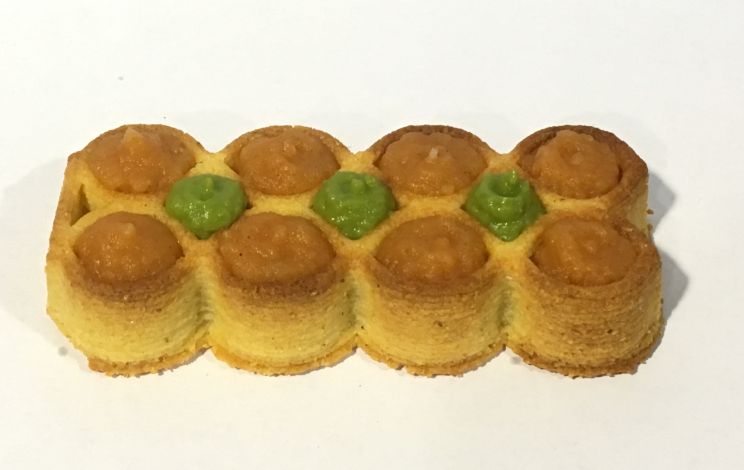24 AUGUST 2023

Example of fully personalized 3D-printed food (Foto TNO)
3D printers have already proven to be capable of printing personalised food items that take personal preferences such as texture and flavour into account. Suzan Wopereis, Principal Scientist at TNO explains: “Now we want to see if we can use the food printer to make a fully personalised product in which nutrient composition is adapted to a person’s physiological needs.” The research is performed within the public-private partnership of IMAGINE, Innovations for the Manufacturing and Marketing of fully personalized food products. The consortium combines the expertise of TNO and Wageningen Food & Biobased Research (WFBR) with that of companies in industrial innovation, food science, personalised nutrition, consumer behaviour and health. The Gelderse Vallei hospital and the Dutch Ministry of Defense contribute with their practical knowledge and experience.
3D printed food is not new. It has already done the market a good turn by personalising texture, shape and flavour. What is new is the personalisation of macro and micro nutrients for certain target groups, such as patients. A personalised food product based on data such as a person’s medical condition, possible comorbidities, nutritional status, as well as age, gender and body composition supplemented with taste and texture preferences, can support recuperation. The aim of this project is to see whether such a personalised food product can be realised and if it is practical in use, both for the patient and hospital staff. On the one hand, the consortium has to adjust software and technology to the wishes and requirements of the health sector. On the other hand, they have to see whether the individual patient appreciates the food product.
Through the kind offices of the Nutrition and Healthcare Alliance (Alliantie Voeding in de Zorg) the consortium cooperates with the Gelderse Vallei hospital to investigate the feasibility of 3D printing in a hospital setting. Suzan explains: “This hospital has gained so much experience with food and food research in a hospital setting, it was obvious we had to cooperate with them. They already have an advanced nutrition system that measures the real-time food intake of patients and links this to all kinds of data, such as the medical signs and symptoms, body composition, food and exercise recommendations and personal treatment plans. Additionally, through the unique meal service every order from every patient is available, as well as how much of that meal was actually consumed. It is important to include this in our investigation.”
Arthur van Zanten, Internist-Intensivist at the Gelderse Vallei hospital and Professor of Nutrition and Metabolic Stress at the WUR, is also pleased with the cooperation: “This research neatly fits our running investigations into the role of nutrition in the recovery from metabolic stress.” This phenomenon occurs when the stress from a serious disease upsets a person’s metabolism, which can lead to an extreme loss of muscle mass, inhibited recovery and persistent symptoms in the longer term. Arthur elaborates: “We noticed that, immediately after being moved from the ICU, patients only consume 50% of the energy and protein they require. We are currently investigating what causes this. IMAGINE is a perfect fit, also considering the transition to a more sustainable healthcare, as well as decreasing the pressure on healthcare personnel. If supply and demand are better balanced, we can waste less food. If we can also increase the intake of plant-based proteins, that will only contribute to our sustainability. In addition, this is a very innovative, futuristic and prestigious project that fits our position as a hospital specialised in nutrition.”
Before the test is started, information will be gathered on the wishes and requirements behind the technology and the food product by interviewing focus groups of patients and their environment. In the past months, research has been done into the possible barriers and opportunities for consumer acceptance. The technology has been adjusted after research was performed within a military setting. This has resulted in the development of a food item: a case made of dough inserted with a filling. Suzan explains: “Participants in the test can chose between sweet or savoury, for instance. The composition of the 3D-printed snack is determined based on individual targets recommended by the nutritional experts at the Gelderse Vallei hospital.” The test participants will have a 3D-printed product on several consecutive days.
A patient will have to be in the hospital for a prolonged time and be conscious in order to be able to test the food product. Preferably, the patient should have been admitted fairly recently. Arthur explains: “After admission to the ICU, we often see distorted memory in patients. Some do not want to be reminded of time there. That is why it is important to interview people about their food preferences immediately after they have left the ICU.” IMAGINE can easily step into any of the research projects Arthur has at the moment. Max Melchers, ICU assistant physician at the Gelderse Vallei hospital and PhD student at WUR will coordinate the project under the supervision of Arthur and researcher Imre Kouw.
The consortium will be active until the end of the project in October 2024. The aim is to develop a prototype that can immediately be deployed in the fieldlabs of the Dutch Ministry of Defense and at Gelderse Vallei. Other partners in the project are: GEA Group, SoliPharma B.V., Tate & Lyle, Nissin, General Mills and the Dutch Ministry of Defense. The public-private partnership project IMAGINE is co-funded by the Dutch Ministry of Economic Affairs, through Top Sector Life Sciences & Health grant no 21074 (WFBR) and 100340397 (TNO) and Top Sector High Tech Systems and Materials grant no 100340397 (TNO).
Further reading: